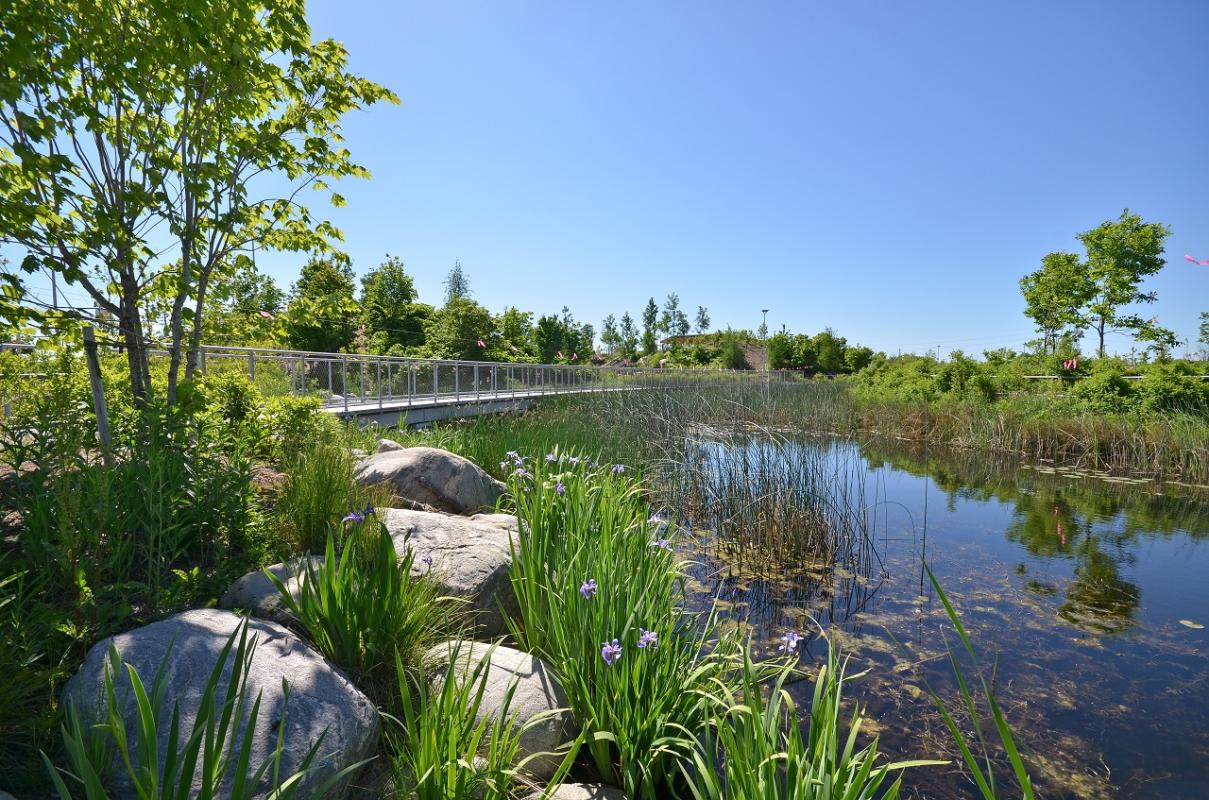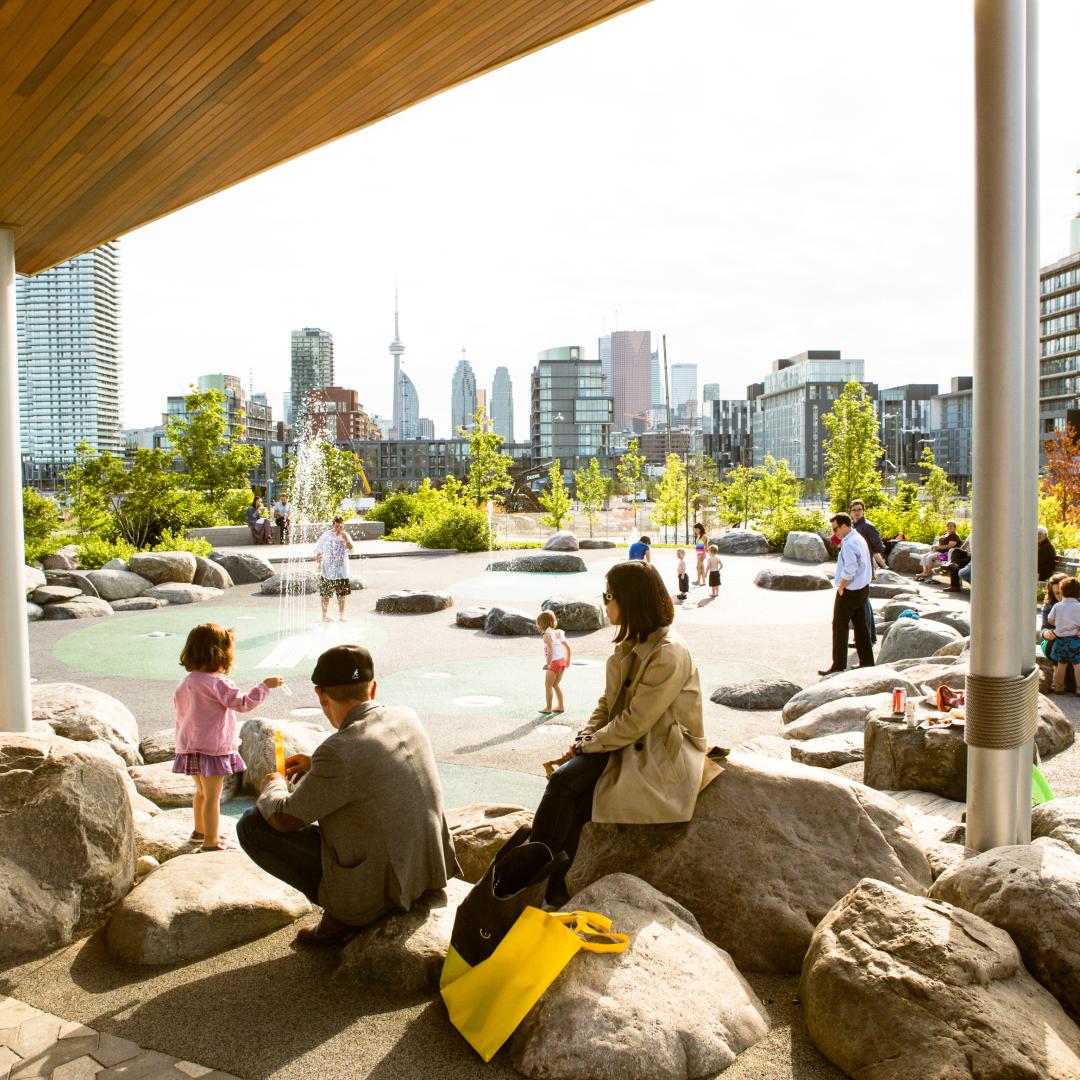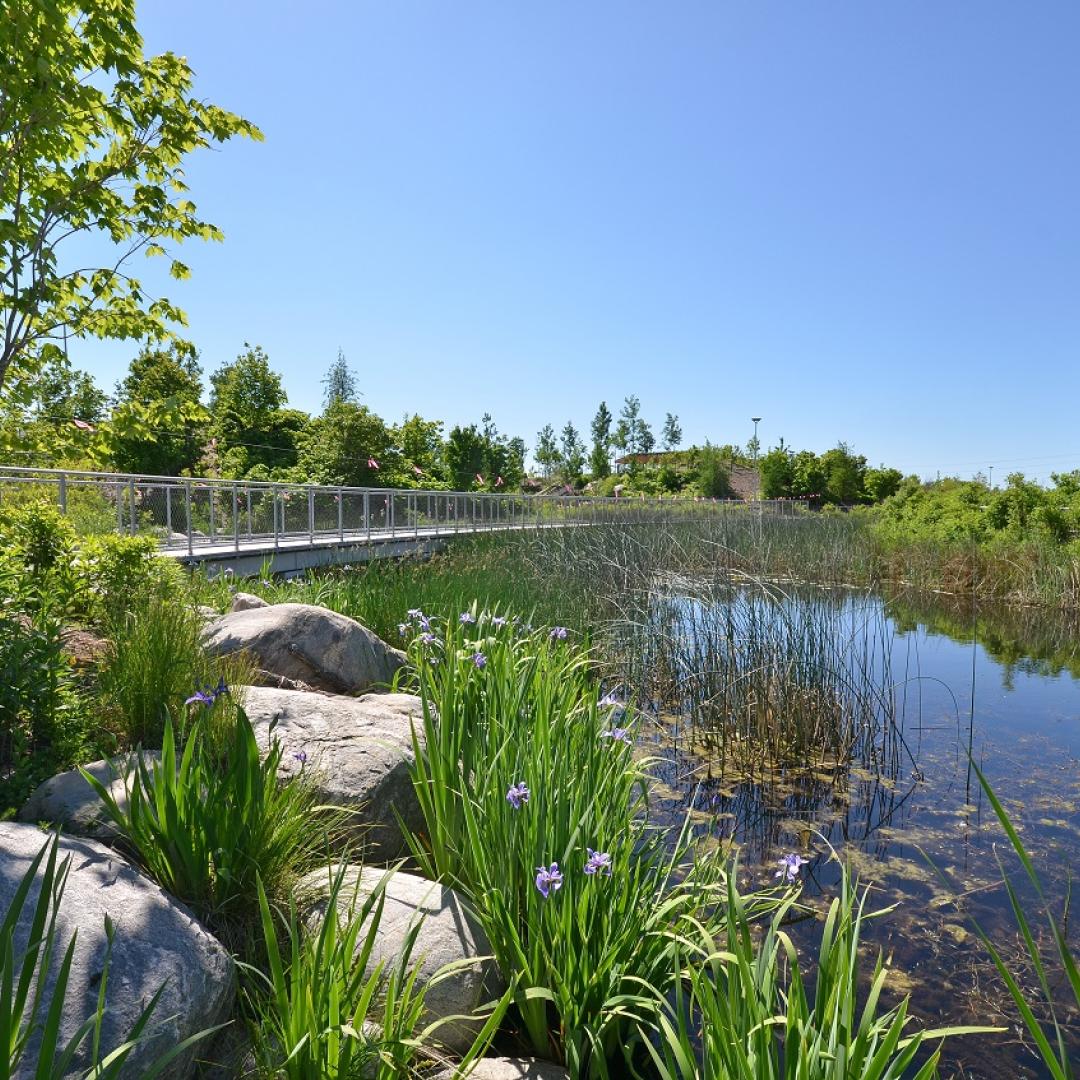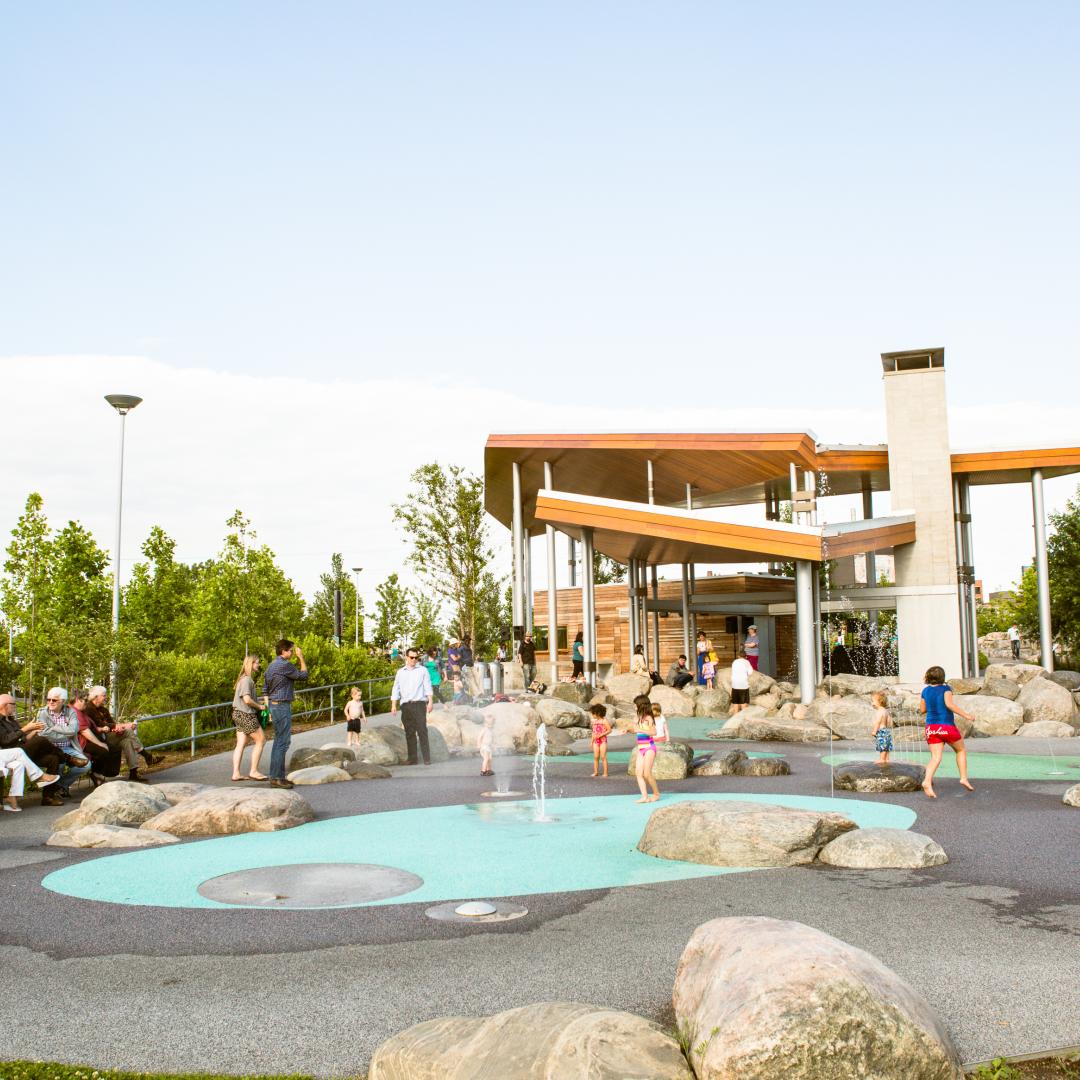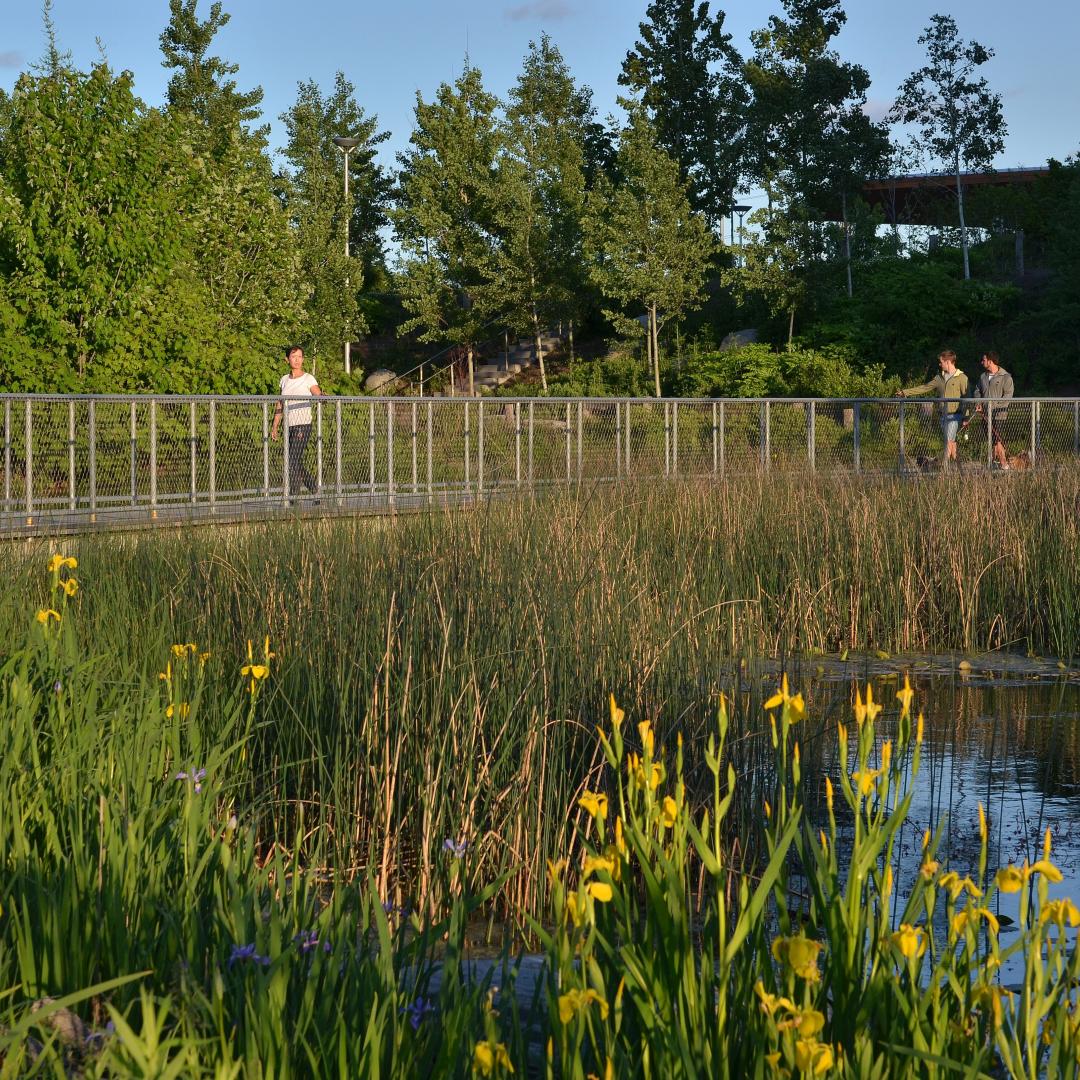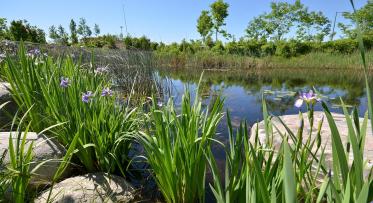Corktown Common
East of Bayview Avenue,
west of GO/CN railroad lines and the Don River,
south of King Street to the rail corridor.
A dynamic park that offers visitors a diverse range of experiences with spectacular views of the city and surrounding area.
Corktown Common, the centrepiece of the emerging West Don Lands, is an active, vibrant and inviting park that serves the local community, residents from across Toronto and visitors from far and wide. At 7.3 hectares (18 acres), it is the largest park in the area.
Innovatively positioned atop the area’s massive flood protection landform (FPL), Corktown Common has leveraged essential public infrastructure to deliver a magnificent public amenity.
Designed by Michael Van Valkenburgh Associates, park features were designed to integrate with the unique contours and elevations provided by the FPL. The design capitalizes on the exceptional landscape, opening sightlines of the Toronto skyline and surrounding communities, creating a sense of scale and grandeur.
Quick Facts
Corktown Common offers something for everyone. The playgrounds, splash pad, athletic field and open lawns can be used for informal gatherings or organized activities. The flexible outdoor space, tables, benches, bbq and fireplace offer welcoming spots for people to meet and socialize.
With more than 700 trees and thousands of shrubs, groundcovers, and aquatic plants, Corktown Common is a diversely planted habitat. Its ecological richness will encourage plant and animal biodiversity and support a healthy forested area within the park. The large marsh, which is an integral part of the onsite stormwater management system, is home to birds, insects, frogs and ducks.
Multiple entrances and a direct link to the Don Valley Trail from an entrance at the improved Bala Underpass offers trail users and park visitor’s access to the river’s edge, the city’s trail system and the nearby waterfront.
Formerly known as Don River Park, Corktown Common was the new name chosen by the public through Name That Park, a six-week online naming contest sponsored by Waterfront Toronto and The Grid. Toronto and East York Community Council approved the new name in June 2013.
Two Disinct Halves
The topography and restrictions imposed by the Flood Protection Landform (FPL) drove the park’s design, landscape and programming.
The 3.6 hectare (8.9 acre) western city side of the park is defined by a dynamic, unfolding topography. Open lawns, knolls (hilltops) and an extensive marsh create distinct rooms that offer varied, flexible spaces for a diverse range of passive and active pursuits. Woodland plantings define each space and screen views of the surrounding urban infrastructure and the elevations provide stunning views of the city from a vantage point not previously available in Toronto.
On the river side of the park, features and plantings were designed to protect the integrity of the flood protection landform which is integral to providing flood mitigation measures in the event of a serious storm in the Don watershed. Meandering trails, multi-use bike paths, a boardwalk and an off-leash dog area are key features of the 3.2 hectare (7.9 acre) urban prairie. Plantings were chosen to respond to the specific site conditions and regulations that restrict active recreation and woody vegetation on the eastern slope of the landform.
visiting the park
- Washrooms and the splash pad are being operated by City of Toronto Parks, Forestry and Recreation.
- The park’s facilities - outdoor fireplace, permanent barbeque, and small kitchenette – are available for programming and permitting through the City of Toronto Parks, Forestry and Recreation.
- You can access Corktown Common from Bayview Avenue at Lower River Street or from the Don Valley Trail at the Bala Underpass. Barrier-free access to the park is from the entrance on Bayview Avenue. The entrance from the Bala Underpass is only by staircase. The park is not accessible by car and parking is not available.
- By transit, take the 504 King streetcar to Lower River Street. Walk south on Lower River Street to the entrance to the park on the east side of Bayview Avenue.
Park Amenities
A spacious playground occupies the park’s central hilltop adjacent to the striking and sustainable pavilion. The play areas bring a high level of activity to the core of the park and offer diverse play experiences for a wide range of ages and abilities. Conventional play equipment such as slides, swings, seesaws, and water play are balanced by natural features, such as rock outcrops and woodlands.
The play hill also features a pavilion that serves the practical needs of the park with enclosed bathrooms, drinking fountains, a small office, a kitchenette and basement utility space that houses the stormwater management equipment. The pavilion also includes a flexible outdoor community room with retractable walls that can be used for meetings, performances and other small-scale community events. A plaza with tables and benches and an outdoor fireplace encourages social gatherings.
A series of open lawns provide ample space for both informal and organized activities. Unfolding at the end of the Front Street Promenade, the park’s large central lawn accommodates a wide range of uses, such as games, picnicking, and sunbathing. With gently sloping sides and ample space for comfortable seating, the central lawn could also be used as an Amphitheatre for performances or community events. In the southern-most part of the park, a non-regulation size athletic field was designed for sports. In the winter, the athletic field serves as the base of a tobogganing hill that rises toward the playground.
The large marsh is wrapped by hills, knolls and woodland vegetation. Supporting plant communities native to the Don River Valley, the marsh references the site’s ecological heritage as a Crown Reserve, providing habitat for wildlife and space for passive recreation. The marsh is also an essential part of the park’s ecological stormwater management system, receiving and treating runoff from the western side of the park.
Lawren Harris Square at Bayview Avenue and Lower River Street is designed to complement Corktown Common and function as an ‘urban square’. The minimalist design, with a crushed granite surface, multiple benches and a simple planting scheme of 24 multi-stem honey locust trees, allows it to function as a multi-purpose community space, offering residents and visitors a place to relax or hold local events. Lawren Harris Square opened in 2014.
Ecology and Sustainability
A closed-loop stormwater recycling system minimizes the amount of treated potable water used for park maintenance needs and solar panels on the pavilion offset the park’s energy consumption.
All of the park’s stormwater, as well as the water discharged from the splash pad feature, is treated using ultraviolet sterilization equipment before being stored in underground storage cells located in the central lawn. The treated water is used for irrigation, park maintenance and to flush the marsh.
The extensive marsh/wetland is one of the ways the park reconnects the former industrial site with the native ecology of the region and is an essential part of the park’s onsite stormwater recycling system. The marsh features approximately 60 species of plants, a weir wall to regulate water levels, and an overflow connect to the municipal stormwater system as back up to prevent park flooding.
The urban prairie on the river side of the park is also a crucial part of the park-wide stormwater recycling system. An upland meadow on the upper slope, with a lowland wet meadow at the base of the landform adds ecological and experiential diversity and support an ecological approach to stormwater management.
Design Teams
Michael Van Valkenburgh Associates, Inc. (lead design firm)
Maryann Thompson Architects (pavilion)
ARUP (engineering)
Pine & Swallow Environmental (planting soils)
Great Eastern Ecology (ecological systems)
Trow (geo-technical)
Creative Irrigation (irrigation)
The Planning Partnership (public consultation)
Greenberg Consulting (urban connections)
Eastern Construction (construction manager)
Aldershot Landscape Contractors (landscape contractor)
Buttcon (pavilion contractor)
Related Documents
View Materials

